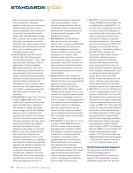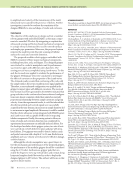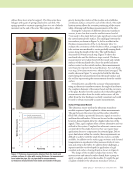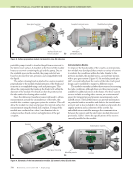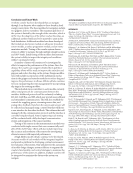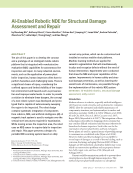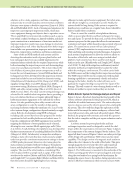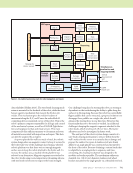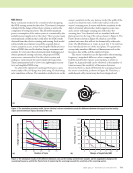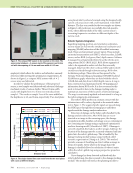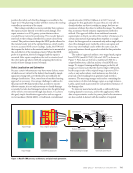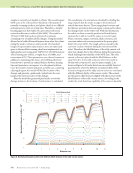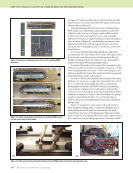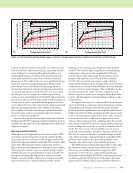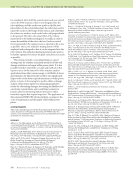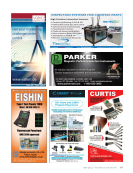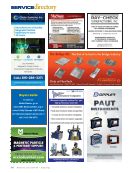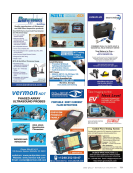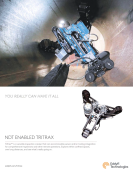J U L Y 2 0 2 1 • M A T E R I A L S E V A L U A T I O N 741 data reliability (Hellier 2013). The wire brush cleaning mech- anism is mounted to the backside of the robot, while the front houses a gantry mechanism that mounts the friction stir welder. This mechanism gives the welder freedom of movement along the X, Y, and Z axes. An embedded AI computing device is mounted on top of the robot. This is the robot’s primary computer responsible for all logic and control of the mechanical systems, as well as all LiDAR (light detec- tion and ranging), inertial, and visual sensors. This main computer also has sufficient memory to document and store all metadata associated with inspection and repair. This data can later be analyzed by an expert. As power plant boiler walls are made of steel, the robotic system design relies on magnetic contact to keep it secured to the boiler wall. One of the challenges faced using a wheeled robotic platform was that there was not enough magnetic surface area to keep the robot attached to the boiler wall. To increase the surface area, a tracked robotic platform was selected as an alternative. Magnetic segments are attached to the robot tracks using room-temperature vulcanizing silicone with steel mesh in between to improve the bond strength. One challenge being faced is steering the robot, as steering is dependent on the tracks having the ability to glide along the surface it is driving along. Because this robot has controllable flipper paddles that can be retracted, a proposed solution is to disengage these paddles on a single side, which should enhance the steering force in one direction. However, this functionality has yet to be tested or verified. An additional challenge is keeping the magnetic segments attached to the robot tracks, which tend to peel off over time. Alternative adhesives need to be investigated in future work. The next part of the robotic system design consists of a wire brush cleaning mechanism to remove debris from the wall’s surface for the sensor to accurately detect damage and prepare the surface for repair. A stainless steel wire brush affixed to an angle grinder was constructed and mounted to the front of the robot. Because obtaining a custom brush that is adaptable to an angle grinder is expensive and time- consuming, the cleaning mechanism was designed to be modular and easily repairable. The mechanism utilizes six standard 4 in. (10.16 cm) diameter stainless steel wheel brushes mounted to the angle grinder via a threaded steel rod. Lock in NDE space Execution Damage analysis Simultaneous localization and mapping (SLAM) Reasoning NDE probe Digital to analog IC Function generator Data management Data fusion and interpretation Odometry Tooling controller Planning Robot control Damage tracking Damage recognition Repair actuator Filtering functionality Data acquisition chip Probe actuator LiDAR Depth cam Moving the robotic system Encoder Inertial measurement unit SLAM GTSAM 3D mapping information fusion Figure 1. AI-enabled autonomy stack for robot navigation and repair. Material under test
742 M A T E R I A L S E V A L U A T I O N • J U L Y 2 0 2 1 The mechanism is attached to the robot chassis using a T-slotted aluminum frame, which can be easily dismantled. A printed circuit board (PCB) with a single pole double throw (SPDT) relay was fabricated to switch the brush system on and off using the general purpose input/output (GPIO) from a microcontroller or single-board computer. The mechanism has been tested by cleaning an A32 steel plate, which can be seen in Figure 2. The last element in the robotic system design is the friction stir welding (FSW) mechanism, which will be used to repair the damage found on the boiler walls. Making modifica- tions to a commercial magnetic drill press was proposed for the design, as this drill could easily meet the desired specifica- tions as well as decrease the time and cost efforts for the project. However, because this drill system has a cast iron frame, it is heavy and has a high center of gravity, which could add instability as well as increase the robot’s energy consump- tion. Other concerns have arisen regarding the drill’s XYZ traverse system: because the system is driven by a threaded screw, backlash could result in impulse force on the FSW tool, which may also lead to damage. In addition, the mechanism that drives the Z axis may not withstand the required plunge force on the tool. Due to all these challenges, it was decided to fabricate a custom gantry system to house the welder instead. As the entire system consumes a lot of energy, the robot is powered via an electrical umbilical cord connected to an alter- nating current (AC) source. This provides enough power to drive the system, as well as prevent the robot from losing power before completing inspection and repair. The bottom row of Figure 2 illustrates the repair gantry mechanism. This mechanism is towed behind the robotic platform. The frame is constructed from 80/20 T-slotted aluminum. Mounted to the frame is a sled mechanism housing a modified Milwaukee drill press, which is used as the FSW repair tool. Encoded motors drive two perpendicular prismatic joints in the X- and Y-planar directions, giving the system two-dimensional repair capabilities at submillimeter precision. The NDE sensor is mounted to the bottom of the sliding mechanism and kept in contact with the boiler wall by a set of springs. An additional encoded motor drives the drill press in the vertical direction. On each corner of the mecha- nism is an electromagnet. When a repair is ready to be executed, these electromagnets are energized, which keeps the system adhered to the boiler wall while the vertical motor applies the required plunge force into the material under repair. An electronics enclosure houses various electronics that give the electromagnets their functionality. A separate electronics enclosure, which is not depicted, houses an embedded single-board computer that controls the system. ME TECHNICAL PAPER w ai-enabled robotic nde for structural damage RGB depth Embedded AI computing device LiDAR sensor Magnetic track system Cleaned A32 plate Angle grinder Wire brush Vertical plunge motor Robotic platform Repair tool Repair tool NDE probe Electromagnet Electronics enclosure Robot chassis NDE sensor Figure 2. Robot system for damage analysis and repair.
ASNT grants non-exclusive, non-transferable license of this material to . All rights reserved. © ASNT 2025. To report unauthorized use, contact: customersupport@asnt.org



























































